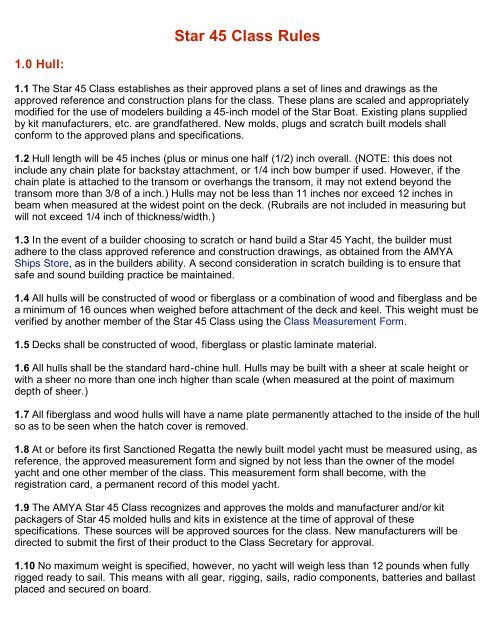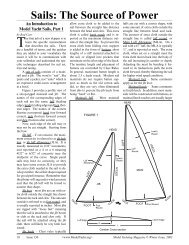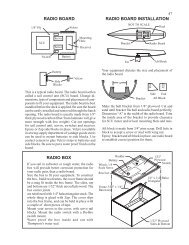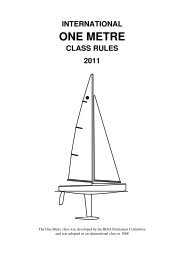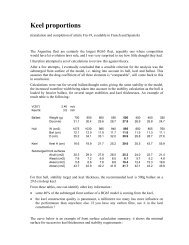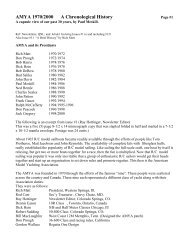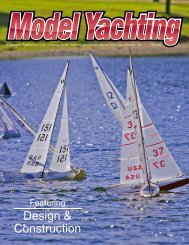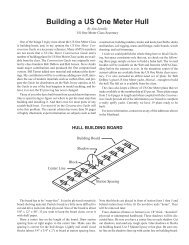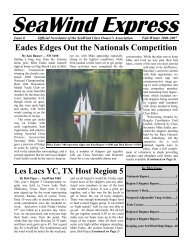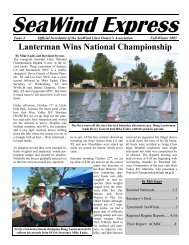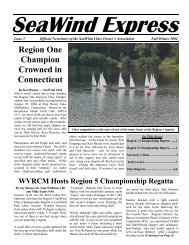Star 45 Class Rules
Star 45 Class Rules
Star 45 Class Rules
Create successful ePaper yourself
Turn your PDF publications into a flip-book with our unique Google optimized e-Paper software.
1.0 Hull:<br />
<strong>Star</strong> <strong>45</strong> <strong>Class</strong> <strong>Rules</strong><br />
1.1 The <strong>Star</strong> <strong>45</strong> <strong>Class</strong> establishes as their approved plans a set of lines and drawings as the<br />
approved reference and construction plans for the class. These plans are scaled and appropriately<br />
modified for the use of modelers building a <strong>45</strong>-inch model of the <strong>Star</strong> Boat. Existing plans supplied<br />
by kit manufacturers, etc. are grandfathered. New molds, plugs and scratch built models shall<br />
conform to the approved plans and specifications.<br />
1.2 Hull length will be <strong>45</strong> inches (plus or minus one half (1/2) inch overall. (NOTE: this does not<br />
include any chain plate for backstay attachment, or 1/4 inch bow bumper if used. However, if the<br />
chain plate is attached to the transom or overhangs the transom, it may not extend beyond the<br />
transom more than 3/8 of a inch.) Hulls may not be less than 11 inches nor exceed 12 inches in<br />
beam when measured at the widest point on the deck. (Rubrails are not included in measuring but<br />
will not exceed 1/4 inch of thickness/width.)<br />
1.3 In the event of a builder choosing to scratch or hand build a <strong>Star</strong> <strong>45</strong> Yacht, the builder must<br />
adhere to the class approved reference and construction drawings, as obtained from the AMYA<br />
Ships Store, as in the builders ability. A second consideration in scratch building is to ensure that<br />
safe and sound building practice be maintained.<br />
1.4 All hulls will be constructed of wood or fiberglass or a combination of wood and fiberglass and be<br />
a minimum of 16 ounces when weighed before attachment of the deck and keel. This weight must be<br />
verified by another member of the <strong>Star</strong> <strong>45</strong> <strong>Class</strong> using the <strong>Class</strong> Measurement Form.<br />
1.5 Decks shall be constructed of wood, fiberglass or plastic laminate material.<br />
1.6 All hulls shall be the standard hard-chine hull. Hulls may be built with a sheer at scale height or<br />
with a sheer no more than one inch higher than scale (when measured at the point of maximum<br />
depth of sheer.)<br />
1.7 All fiberglass and wood hulls will have a name plate permanently attached to the inside of the hull<br />
so as to be seen when the hatch cover is removed.<br />
1.8 At or before its first Sanctioned Regatta the newly built model yacht must be measured using, as<br />
reference, the approved measurement form and signed by not less than the owner of the model<br />
yacht and one other member of the class. This measurement form shall become, with the<br />
registration card, a permanent record of this model yacht.<br />
1.9 The AMYA <strong>Star</strong> <strong>45</strong> <strong>Class</strong> recognizes and approves the molds and manufacturer and/or kit<br />
packagers of <strong>Star</strong> <strong>45</strong> molded hulls and kits in existence at the time of approval of these<br />
specifications. These sources will be approved sources for the class. New manufacturers will be<br />
directed to submit the first of their product to the <strong>Class</strong> Secretary for approval.<br />
1.10 No maximum weight is specified, however, no yacht will weigh less than 12 pounds when fully<br />
rigged ready to sail. This means with all gear, rigging, sails, radio components, batteries and ballast<br />
placed and secured on board.
1.11 Bow Bumpers are mandatory for all class registered STAR <strong>45</strong> yachts. Bow bumpers are limited<br />
to three eight's of an inch (3/8") overhang. Bow bumpers shall be excluded in the overall length<br />
measurement, whether recessed in or otherwise attached to the bow stem. Bow bumpers must be of<br />
resilient fabrication to minimize damage to another yacht in the event of a collision.<br />
2.0 SAILS:<br />
2.1 Sails may be of single or multi-paneled construction. Sail material shall be unrestricted.<br />
2.2 All sails are to be cut to comply with the following maximum dimensions when measured by the<br />
procedure as outlined in the "AMYA Regulations". Dimensions shown are measured 'Edge of Cloth"<br />
to "Edge of Cloth" and are in inches.<br />
2.3<br />
MAIN JIB<br />
Luff 62.75 42.50<br />
Foot 25.50 15.75<br />
Leech 65.50 37.00<br />
Roach 2.00 0.50<br />
Head 0.75 0.75<br />
Foot Round 0.50 0.50<br />
2.4 All sails, main and jib, will be cut with either a straight head to clew leech with no roach, or a fair<br />
curved head to clew leech with the maximum roach point occurring approximately one half the<br />
distance from the clew to head. Divide a straight line from the aft corners of the Clew and Head into<br />
four (4) equal sections. Then, for the Main Sail, maximum offset from edge of cloth for the Roach at<br />
the quarter points to be 1.75" and the offset at the mid-point to be 2.0". For the Jib, the offset at the<br />
quarter points to be 0.375" and at the mid-point to be 0.50". Sails cut with a straight leech at the<br />
maximum roach allowance are prohibited from use on the <strong>Star</strong> <strong>45</strong> <strong>Class</strong> Yacht.<br />
2.5 The mainsail gooseneck or attachment will be attached to the Mast between 0.50 inch minimum<br />
to 4.0 inch maximum measured from the deck.<br />
2.6 Battens are allowed on the mainsail but are restricted to 4 in number, equally spaced along the<br />
leech and may not exceed 8.50 inches in length. Battens are not permitted in the jib sail.<br />
2.7 Sailmakers must conform to the above measurements.<br />
2.8 Standing rigging is not specified except for the height of the jib stay attach point on the mast,<br />
which will not exceed 54 inches above the deck when measured from the deck at the mast step<br />
point, and mast head fittings are limited to a projection of 3.0 inches behind the mast. Control of<br />
standing rigging by other than manual manipulation (Hand Turning) is prohibited.
2.9 The <strong>Class</strong> Secretary maintains a master sail measurement template. Sail measurement<br />
templates shall be kept current with the class specifications as well as new motions passed by the<br />
rank and file. Templates shall be made of material consistent of lasting shape. Templates shall be<br />
made available for AMYA sanctioned regattas upon request from the hosting AMYA sanctioned club.<br />
Other non-sanctioned regattas may request templates which is subject to availability and discretion<br />
of the <strong>Class</strong> Secretary.<br />
3.0 MAST:<br />
3.1 Masts shall be made of wood or aluminum. Swing rigs, rotating and permanently bent masts are<br />
prohibited.<br />
3.2 Masts shall not exceed 3/4 inches square when measured at the thickest point of the mast.<br />
Maximum mast height shall be 70" when measured from the deck, inclusive of the crane. Rotating<br />
wind indicators and burgee staffs are not included provided the backstay is not attached to them in<br />
order to circumvent the 70" maximum mast height specification.<br />
4.0 BOOMS:<br />
4.1 The main boom and jib club shall not exceed 5/8" when measured at the thickest point. Booms<br />
and jib clubs shall be constructed of wood, aluminum and/or fiberglass.<br />
5.0 RADIO CONTROL SYSTEMS:<br />
5.1 Radio control systems of any number of channels may be used but the functions are limited to<br />
the rudder, sail control (jib sheets and main sheet) using no more than three servos. Control of the<br />
jib may be separate or may be combined in one function.<br />
6.0 RUDDER:<br />
6.1 Rudders may be constructed of wood, fiberglass, plastic, plastic laminates or metal. The exact<br />
shape is not specified, but they may not exceed 4 1/2 inches at the hull (fore and aft) 3 inches at the<br />
bottom, (fore and aft); and may not project more than 7 inches below the hull when measured at the<br />
post.<br />
7.0 KEELS AND BALLAST BULBS:<br />
7.1 Keel will be of the style known as drop, and will be of the FIN and BULB type.<br />
7.2 Keel fins may be solid or hollow and constructed of reinforced plastic, plastic laminates,<br />
fiberglass, wood or metal. (Note: Strength and integrity of the keel fins must be maintained whether<br />
built solid or hollow.) Keel fin shape is not specified but must follow the general shapes outlined on<br />
the reference drawing. However, keels will not be less than 6 inches nor more than 8 inches long<br />
(Fore and Aft) at the keel/hull junction, nor less than 4 inches nor more than 6 inches long (Fore and<br />
Aft) at the keel/ballast bulb junction.
7.3 Keels, keel fins and ballast bulbs may be removable, however, they may not be changed,<br />
interchanged, substituted or otherwise manipulated once any heat or series of heats in which scores<br />
will be compiled, has started. Mechanically movable keels or ballast bulbs are specifically prohibited<br />
from use in <strong>Star</strong> <strong>45</strong> <strong>Class</strong> Yachts.<br />
7.4 Ballast bulbs may be constructed of any material not prohibited by the AMYA. The actual shape<br />
is left to the builder's discretion, but will not exceed 9.75 (9 3/4) inches from the front of the keel bulb<br />
to the rearmost point of the keel or bulb.<br />
7.5 Total drop (length) of the keel fin/ballast bulb combination will not exceed 11.5 (11 1/2) inches<br />
when measured from the keel/hull junction, before any fillers or streamlining is added.<br />
7.6 Ballast may be made from any readily available material, such as poured lead, lead shot, etc.<br />
(Note: When using material such as lead shot, the mass must be solidified through the use of a<br />
bonding agent such as fiberglass or epoxy resin, plaster of paris, poured over and through in order to<br />
create a solid mass.)<br />
7.7 Race directors may elect to use a template based on the construction plans to determine the keel<br />
length (depth).<br />
7.8 Keel depth shall be measured from the center of the keel fin at the hull to the bottom of the<br />
ballast bulb. This measurement is from the edge of the bottom of the hull as it meets the side of the<br />
keel and should be determined during construction and before any fillet or fairing is added.<br />
7.9 The <strong>Star</strong> <strong>45</strong> <strong>Class</strong> specifically excludes radio equipment, sail controls and batteries (power cells)<br />
from being considered ballast. This specification defines ballast as anything carried aboard the<br />
model for the main purpose of changing the weight distribution of the model and/or weight of the<br />
model. Ballast shall be fixed in place by gluing, fiberglassing, or bolting (bolts and screws).<br />
7.9.1 Ballast may not be removed or relocated during any one regatta. The use of Velcro or similar<br />
quick release fasteners is prohibited as methods of mounting ballast.<br />
8.0 DECK:<br />
8.1 Deck construction shall be limited to wood, plywood, fiberglass reinforced plastic or plastic<br />
laminations (Formica). It may be covered with any material. Thin plastic films, such as MonoKote,<br />
are not allowed for decks except as coverings.<br />
8.2 Hatches are not restricted in size, location, number or style, as long as deck strength and<br />
integrity are maintained.<br />
9.0 DISTINGUISHING MARKS:<br />
9.1 Each yacht shall carry on her main sail the class 5 point "STAR EMBLEM" and an assigned<br />
AMYA registration number. The star shall be at least 2 inches in size (measured from point to point<br />
across the flat of the star) and positioned above the registration number. Registration numbers shall<br />
be at least 3 inches in height and at least 3/8 inch thick. Both star and registration numbers will be<br />
placed on the upper half of the mainsail on both port and starboard sides of the mainsail and shall be<br />
positioned so as to be easily read from either side.
10.0 MANUFACTURERS PROCEDURES:<br />
10.1 The following are procedures that must be followed by manufacturers, class secretaries and<br />
scratch builders, who are going to make more than one hull for sale.<br />
10.1.1 The builder shall send to the class secretary proof of craftsmanship, hull by means of<br />
transportation of the builder's choice.<br />
10.1.2 The class secretary will, upon receiving hull for measurement, notify the builder of the<br />
condition of the hull.<br />
10.1.3 The class secretary will measure the hull.<br />
10.1.4 When measuring hull the class secretary will request a <strong>Star</strong> <strong>45</strong> owner to assist with the<br />
measuring.<br />
10.1.5 The class secretary will measure the hull, using the templates of the hull pictured in the<br />
approved plans.<br />
10.1.6 The templates will be made of Plexiglas or wood (not Balsa).<br />
10.1.7 The membership can request a copy of these templates by sending a request to the class<br />
secretary. These templates have been taken from the approved plans and are true and accurate.<br />
10.1.8 The class secretary upon completion of the measuring will return the hull to the builder. The<br />
class secretary will also assign a number for the hull, if approved. Each hull will be measured<br />
regardless of condition. The manufacturer will keep in his possession a record of as to whom he sold<br />
hulls.<br />
11.0 AUTHORIZATION FOR CLASS SECRETARY:<br />
11.1 The class secretary shall be authorized to conduct class business such as granting interim<br />
approval to molds, manufacturers and similar approvals provided those actions are reported in the<br />
newsletter.<br />
12.0 SPECIFICATIONS:<br />
12.1 These specifications shall take precedent over any other document.
STAR <strong>45</strong> CLASS<br />
Measurement Form<br />
____________________________________________ ___________________<br />
Skipper or Owner Registration Number<br />
HULL:<br />
Fiberglass:____________ Wood: ______________<br />
Length: <strong>45</strong>” +- 1/2” (Rule 1.2) ________________<br />
Width: 11” to 12” (Rule 1.2) ________________<br />
Hull Weight (Rule 1.4) ________________<br />
Deck Material (Rule 1.5) ________________<br />
Name Plate attached (Rule 1.7) ________________<br />
Bow Bumper installed (Rule 1.11) ________________<br />
Any attachment or fitting that extends beyond the hull when measured vertically from the edge of the hull (and<br />
perpendicular to the waterline) is to be considered part of the overall length of the hull and rule 1.2 applies<br />
SAILS:<br />
Measured “Edge of cloth to edge of cloth” (Rule 2.2) Maximum Roach is 2.0” on Mainsail and 0.5” on Jib (Rule 2.3)<br />
Luff Foot Leech Roach Head Foot Round<br />
Main: 62.75 _______ 25.50 _______ 65.50 ______ 2:00 ______ 0.75 _____ 0.50 ___<br />
Jib: 42.50 _______ 15.75 _______ 37.00 _______ 0.50 _______ 0.75 ______ 0.50 ___<br />
MAST & RIGGING:<br />
Aluminum _______ Wood ______ (Rule 3.1)<br />
Mast Crane not to exceed 3” behind mast (Rule 2.8) ___________<br />
Jib stay attachment not to exceed 54” above deck (Rule 2.8) ___________<br />
Mast Length not to exceed 70” above deck (Rule 3.2) ___________<br />
Mast not to exceed 3/4” square (Rule 3.2) ___________<br />
Aluminum ______ Wood _______<br />
Boom and Jib Club not to exceed 5/8” square (Rule 4.1) ___________<br />
Aluminum _______ Wood ________ Fiberglass ___________<br />
If any part of the jib club, any jib club attachment, or any counterweight extends beyond the bow of the boat<br />
when measured vertically from the leading edge of the bow, it needs to be included in the total length of the hull and<br />
may not then exceed <strong>45</strong>.5 inches as per rule 1.2<br />
Rear Chain plate cannot extend past transom more than 3/8” ___________<br />
from a vertical line perpendicular to the water line (Rule 1.2)<br />
RUDDER:<br />
May not exceed 4.1/2” at Hull: ______, 3.0” at bottom: ______, and shall not project ___________<br />
more than 7.0” below the Hull at post: ______ (Rule 6.1)<br />
Rudder post position from stern 6” as per drawing ___________<br />
2003 revision<br />
1
KEEL & BULB:<br />
2003 revision<br />
STAR <strong>45</strong> CLASS<br />
Measurement Form<br />
Bulb to be of a length not greater than 9.3/4” (Rule 7.4) ________<br />
Keel width not to exceed 8.0” or less than 6.0” when _________<br />
measured at the Hull (Rule 7.2)<br />
Keel width not to exceed 6.0” or less than 4.0” when __________<br />
measured at the keel/ballast bulb junction (Rule 7.2)<br />
Maximum depth of keel and bulb will not exceed 11.1/2 __________<br />
total drop (Rule 7.5)<br />
WEIGHT:<br />
Total weight cannot be less than 12 lb. including all gear, ___________<br />
rigging, sails, radio components, batteries and ballasting (Rule 1.10)<br />
HULL MANUFACTURER:<br />
Self Built: _________ Manufacturer: ____________<br />
SAIL MANUFACTURER:<br />
Self Built: __________ Manufacturer: ____________<br />
REMARKS:<br />
________________________________________ _______________________________<br />
Skipper or Owner Measurer<br />
_________________________________________ ________________________________<br />
Date<br />
2<br />
_________________________________<br />
Note:<br />
These are the minimum measurements to be performed at regattas. This is not the definitive list of class rules. The<br />
written rules and the plans need to be considered together for the actual rules in totality.<br />
This minimum list of required measurements is subject to change and other rules may be verified or measured.<br />
Therefore this should not be used as a guideline for building in and of itself, but merely as it is written and intended,<br />
that is it being the current measurement check-in for officially sanctioned regattas.


